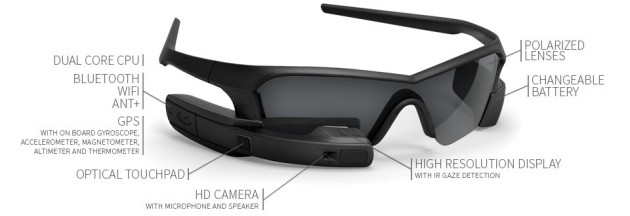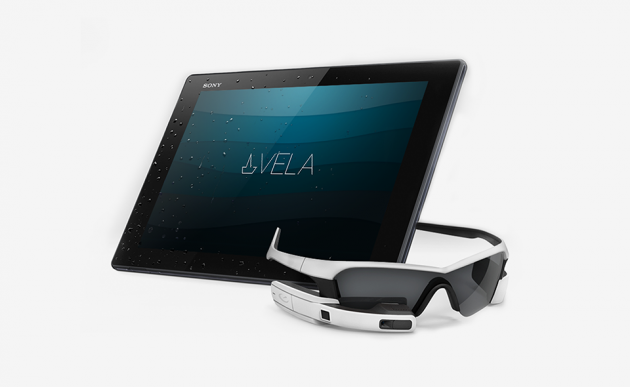Rise of the Machines: Wearable Computers Come to Boating
Ever get tired of having to constantly have your eyes on your instruments, not the horizon? A new generation of wearable computers aims to solve that problem.
With the proliferation of digital instruments and smartphone applications, we have become accustomed to having lots of data, such as our route, position, and tides right at our fingertips. Unfortunately, however, there is a consistent problem with this form of navigating: You have to look away from your surroundings to see it. This creates an up and down bobble head effect, much like you see when people try the deadly habit of texting while driving.

Recon Jet is a powerful, standalone microcomputer with on-board processing power, a suite of sensors, and networking capabilities.
The solution to this problem is wearable computers. While some of the spotlight has been on smart watches lately, there is a lot of buzz around smart glasses—head mounted displays with cameras, such as Google Glass. We saw smart glasses in use during the America’s Cup. Now, you too can now look like the Terminator and have all of your boat data right in your line of vision.
Two companies are taking the lead in this space: Afterguard and Vela. Both are designed to work with Recon Instruments and its “Recon Jet” weatherproof Heads-up Display (HUD) sunglasses. Having started in the cycling segment, the company is taking its base glasses and software and customizing them specifically for sailors.
Afterguard Marine’s Afterguard product is targeted at the recreational sailboat racer. The Afterguard glasses connect via Wi-Fi to your boat’s existing instruments through an on-board control unit to display a host of information for decision making underway. When you’re trying to make a million decisions at once, this means no more shouting at your crew to get out of the way or straining your eyes to read the digits 20 feet away.
Here's a video from Afterguard:
Along with the general boat speed, velocity made good, and start line time to kill data, what is especially cool about Afterguard is the virtual tactician view. This uses a three-dimensional magnetometer to provide a visual of your tacking angles, and also what they call a clearing line, which shows you whether you are ahead or behind a boat coming across you. This makes the decision to cross ahead or duck behind a much easier call. Although it does not mean an excuse for bad judgment, I can just see the situation in the post-race briefing. “Hey, Afterguard told me I could cross!”

Afterguard screens: The Performance Dashboard, the Start Sequence screen, and the Virtual Tactician screen.
Video is also integrated into these glasses, making it very easy to snap a short high-definition video of your kids or a buoy rounding. Battery life is a limitation here for sure, and while using the HUD alone will get four to six hours of life, video will drain these glasses very quickly. A yet-to-be-released, must-have feature will be interchangeable lenses, for very bright conditions, or clear lenses for folks like us in the Pacific Northwest when it is grey and raining.
Another company that is making products for use with Recon Jet is Vela, a company which is is based in the United Kingdom and targeting the casual sailor. These are folks who go out for a weekend and use their tablet for navigation and local harbor information or weather.
Annalisa Cividati, who is the lead designer, states, “We are bringing really high quality design to a new platform in the nautical world, and looking for ways to augment and improve the experience with technology in new and exciting ways.” The Vela system works with an Android tablet application over Wi-Fi or Bluetooth so the sailor can plan their trip on their tablet before the leave home, and then view data en route in real-time with the Recon Jet HUD.

VELA works with your existing Android tablet to repeat navigation, harbor, weather and other information on a pair of Recon Jet smartglasses.
Vela also is looking to work with existing Android smartphone apps. It is just starting to build a prototype to showcase the capabilities, and a retail plan is in progress. For maneuvering into a tricky harbor, I really like seeing the boat location and details of the chart right in my view. As such, the Vela has the potential to reach a broader set of boating users, although I don’t see the problems solved as acute as they are with a racer.
Here's a demo video from Vela:
http://vimeo.com/81538305
Expect to see these glasses appearing towards the end of 2014. The pre-order price
for the Afterguard is $1,899, while the price for the Vela is not yet available.
It will be interesting to see the response from class organizers, marine electronics companies, and other equipment manufacturers, as I think this is just the start. The opportunities in this space are vast. I also see the potential for the data to be collected for analysis or sharing off the boat. It would be great to see these in later versions of the products. And can you imagine a voice command in combination with this. It could be a useful "Tim, there is a storm coming," or the more annoying "Tim, please don’t ignore me… I said tack NOW!"
Where Google Glass is reshaping social etiquette, I am sure these will impact our boating rules and norms. And one day, if you see a robot driving the boat next to you, you may not be imagining things.
For more information, visit Recon, Afterguard, or Vela.











